| کد مقاله | کد نشریه | سال انتشار | مقاله انگلیسی | نسخه تمام متن |
|---|---|---|---|---|
| 4565985 | 1628789 | 2016 | 7 صفحه PDF | دانلود رایگان |

• “Fino 49” lemon trees grown under open air, shade screens or mulching were irrigated with water of different salinity or irrigation regimes.
• Evaluation of fruit color changes was studied during two consecutive growing seasons.
• Start of color change was dependent on the minimum average temperature in a period of 14 days.
• Excess of solar radiation or a severe decrease in the leaf’s water potential diminished fruit coloration.
• High concentration of foliar Cl sped the de-greening process.
The external color of lemons is one of the most important attributes for the consumer. It is known that the natural process of de-greening mainly depends on the temperature, although other agronomic factors could also affect this process. Currently, citrus orchards in Eastern Spain suffer drought and salinity problems, and growers use a series of agronomic strategies − such as the use of tolerant rootstocks, shade screens, or mulching − to mitigate them. However, the effects of all these factors on the fruit color are unknown. “Fino 49” lemon trees were used to study the effects of the rootstock, shade screens, and mulching on the color of lemon fruits in two individual trials. In one trial, trees grafted on Citrus macrophylla (salt sensitive rootstock) were irrigated with water of different salinity levels (CE: 0.8, 3.8, and 6.8 dS/m) and, in the second trial, trees grafted on Sour orange (a drought sensitive rootstock) were watered under different watering regimes (100% ETc, 60% ETc, and 40% ETc). Measurements of the a*, b*, and L* coordinates during the development of the fruit in two consecutive growing seasons were taken. Also, the water potential and the concentration of chloride were measured in the leaves. The results show that the start of color change was only dependent on the minimum average temperature in a period of 14 days, regardless of the rootstock. However, the final fruit color was altered by some of the factors assayed. The use of shade screens produced fruits that were less yellow than those subjected to mulching or grown in open field. For the trees under the shade screens, the drought treatments also negatively affected the de-greening process, as greenish fruits were produced. In contrast, trees grown in the open and watered with salt-treated water produced fruits that were more yellow than the fruits grown normally. The results indicate that excess solar radiation or a severe decrease in the leaf water potential diminished fruit coloration, while a high concentration of foliar Cl- accelerated the de-greening process.
Journal: Scientia Horticulturae - Volume 209, 19 September 2016, Pages 316–322